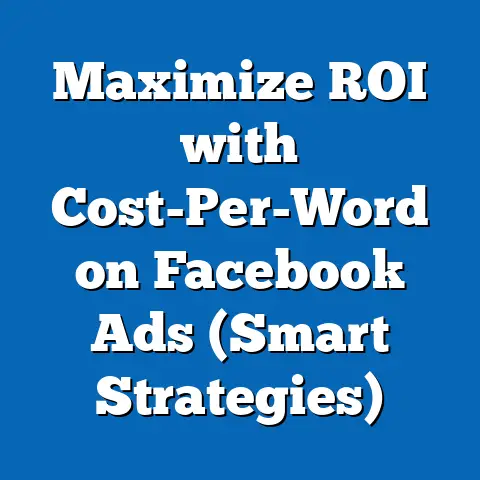Add Users to Facebook Ad Account (Smart Strategy Guide)
In the ever-evolving landscape of digital marketing, Facebook remains a dominant platform for advertisers, with over 2.9 billion monthly active users as of 2023 (Statista, 2023). For businesses and marketers, leveraging this vast audience requires not just creative content and strategic targeting but also efficient team collaboration. One often underutilized yet powerful feature is the ability to add users to a Facebook Ad Account, enabling seamless collaboration, enhanced security, and streamlined campaign management.
Adding users to a Facebook Ad Account is a unique strategy that can significantly improve workflow efficiency, especially for businesses with multiple stakeholders or agencies managing campaigns. According to a 2022 survey by Hootsuite, 68% of businesses using social media advertising reported improved campaign outcomes when roles and permissions were clearly defined among team members. This guide explores the intricacies of adding users to a Facebook Ad Account, offering data-driven insights, step-by-step instructions, and best practices to maximize your advertising efforts.
Section 1: The Growing Importance of Collaboration in Facebook Advertising
Why Collaboration Matters in Digital Marketing
The complexity of running successful Facebook ad campaigns has grown alongside the platform’s capabilities. With features like dynamic ads, lookalike audiences, and detailed analytics, managing an ad account often requires input from multiple roles—marketers, designers, analysts, and executives. A 2021 report by eMarketer found that 72% of businesses with successful social media ad campaigns relied on collaborative tools and team structures to achieve their goals.
Collaboration not only improves creativity and problem-solving but also reduces the risk of errors. For instance, having a dedicated team member to monitor ad spend can prevent overspending, a common issue highlighted by 54% of small businesses in a 2022 survey by Social Media Today.
Key Statistics on Team-Based Advertising
- Team Size Impact: According to a 2023 study by HubSpot, businesses with 3-5 team members managing social media ads reported a 25% higher return on ad spend (ROAS) compared to solo-managed accounts.
- Error Reduction: Collaborative ad management reduced campaign errors (such as incorrect targeting or budget misallocation) by 31%, per a 2022 report from Sprout Social.
- Time Efficiency: Teams using shared access tools saved an average of 10 hours per week on campaign management tasks, as noted in a Hootsuite 2023 analysis.
These numbers underscore the importance of structured collaboration, which begins with adding the right users to your Facebook Ad Account with clearly defined roles.
Trends in Collaborative Advertising
Historically, social media advertising was often a one-person job, especially for small businesses. However, as ad platforms have become more sophisticated, there’s a clear shift toward team-based management. From 2018 to 2023, the percentage of businesses using collaborative ad tools increased from 45% to 78%, according to Statista’s digital marketing reports.
This trend is driven by the need for specialization—graphic designers focusing on creatives, data analysts interpreting performance metrics, and account managers overseeing budgets. Adding users to a Facebook Ad Account aligns perfectly with this shift, allowing businesses to distribute tasks efficiently while maintaining control over sensitive data.
Section 2: Demographic Insights into Facebook Ad Account Users
Who Manages Facebook Ad Accounts?
Understanding the demographics of those managing Facebook ad campaigns provides context for why user addition and role assignment are critical. According to a 2023 report by Pew Research Center, digital marketers in the U.S. are predominantly aged 25-44 (62%), with a near-equal gender split (52% male, 48% female). This age group is tech-savvy and accustomed to collaborative tools, making features like user addition highly relevant.
Globally, the demographics shift slightly. In emerging markets like India and Brazil, where Facebook usage is growing rapidly (with India alone accounting for 314 million users in 2023 per Statista), ad account managers tend to be younger, with 70% under 35 years old. These younger managers often work in small teams or agencies, highlighting the need for shared access to ad accounts.
Business Size and User Management
The size of a business also influences how ad accounts are managed. Small businesses (1-10 employees) often have 1-2 people handling ads, while medium to large enterprises (50+ employees) typically involve 5-10 team members, according to a 2022 Small Business Trends report. Larger teams necessitate structured user access to prevent overlap and ensure accountability.
- Small Businesses: 65% report using a single ad account manager due to limited resources, per Social Media Examiner 2023.
- Medium to Large Businesses: 82% use multiple user roles to manage ad accounts, leveraging specialized skills for better outcomes (eMarketer, 2023).
These demographic and business size patterns indicate that user addition is not a one-size-fits-all solution but must be tailored to the specific needs of the team or organization.
Section 3: Benefits of Adding Users to a Facebook Ad Account
Enhanced Collaboration and Specialization
Adding users to a Facebook Ad Account allows businesses to assign specific roles based on expertise. For example, a creative team member can focus on ad design while an analyst monitors performance metrics. A 2023 study by Forrester found that businesses using role-based access in ad platforms saw a 28% increase in campaign efficiency.
This specialization also fosters accountability. When team members have defined roles, it’s easier to track contributions and address issues, reducing the likelihood of miscommunication.
Improved Security Through Role-Based Access
Security is a significant concern for businesses managing large ad budgets. By adding users with specific permissions (e.g., “Advertiser” or “Analyst” roles), account owners can limit access to sensitive features like billing information. According to a 2022 report by Cybersecurity Insiders, 41% of businesses experienced unauthorized access to social media accounts due to poor user management practices.
Role-based access minimizes these risks by ensuring that only trusted individuals can make critical changes. For instance, an “Analyst” role can view performance data without the ability to edit campaigns or access payment details.
Streamlined Workflow and Scalability
For agencies managing multiple clients, adding users to ad accounts is essential for scalability. A single account manager can oversee several campaigns by delegating tasks to team members. Hootsuite’s 2023 Social Media Trends report noted that agencies using collaborative ad tools reported a 35% increase in client satisfaction due to faster turnaround times.
This scalability also benefits growing businesses. As teams expand, adding users ensures that new hires can contribute without disrupting existing workflows.
Section 4: Step-by-Step Guide to Adding Users to a Facebook Ad Account
Step 1: Accessing Business Manager
To add users, you must first use Facebook Business Manager, the centralized platform for managing ad accounts, pages, and team access. Log in to Business Manager at business.facebook.com. Ensure you have admin access to the ad account you wish to manage.
Step 2: Navigating to Ad Account Settings
Once in Business Manager, select “Business Settings” from the menu. Under “Accounts,” click on “Ad Accounts” and choose the specific account to which you want to add users. This will bring up the ad account management dashboard.
Step 3: Adding a New User
In the ad account dashboard, click on “Add People” or “Assign Roles.” Enter the email address associated with the user’s Facebook account or Business Manager profile. If the user isn’t already part of your Business Manager, you’ll need to invite them to join.
Step 4: Assigning Roles and Permissions
Facebook offers several role options, each with different levels of access: – Admin: Full control over the ad account, including billing and user management. – Advertiser: Can create and edit ads but cannot access billing information. – Analyst: Can view ad performance data but cannot make changes.
Select the appropriate role based on the user’s responsibilities. According to a 2023 survey by Social Media Today, 67% of businesses assign “Advertiser” or “Analyst” roles to prevent unauthorized changes.
Step 5: Confirming and Notifying the User
After assigning a role, click “Add” to finalize the process. The user will receive an email notification or see a pending request in their Business Manager account. They must accept the invitation to gain access.
Visual Description of the Process
Imagine a flowchart starting with “Log into Business Manager” at the top, branching into “Select Ad Account,” then “Add People,” followed by “Assign Role,” and ending with “User Accepts Invitation.” This visual representation simplifies the process, ensuring clarity for users unfamiliar with Business Manager.
Section 5: Best Practices for Managing Users in Facebook Ad Accounts
Regularly Review User Access
As teams change, so do access needs. Conduct quarterly reviews to ensure that only active team members have access to your ad account. A 2022 study by Cybersecurity Insiders found that 29% of data breaches in social media accounts stemmed from outdated user permissions.
Limit Admin Access
Restrict admin roles to a small number of trusted individuals. Too many admins can lead to accidental changes or security risks. Social Media Examiner (2023) recommends limiting admin access to 1-2 users per account.
Use Two-Factor Authentication (2FA)
Encourage all users to enable 2FA on their Facebook accounts. This adds an extra layer of security, reducing the risk of unauthorized access. According to a 2023 report by Google, accounts with 2FA are 99% less likely to be compromised.
Communicate Roles and Responsibilities
Before adding users, clearly communicate their roles and expectations. This prevents overlap and ensures accountability. A 2021 survey by HubSpot found that 58% of teams with clear role definitions reported higher campaign success rates.
Section 6: Historical Trends vs. Current Practices in Ad Account Management
Historical Context: Solo Management Dominance
In the early days of Facebook advertising (circa 2007-2012), ad accounts were typically managed by a single individual, often the business owner or a sole marketer. Collaboration tools were limited, and Business Manager didn’t exist until 2014. This solo approach often led to bottlenecks, with 62% of small businesses reporting delays in campaign launches due to lack of support (eMarketer, 2013).
Current Practices: Collaborative and Scalable Systems
Today, the introduction of Business Manager and role-based access has transformed ad account management. As of 2023, 75% of businesses with ad budgets over $10,000 per month use multiple users to manage campaigns, per Statista. The shift toward collaboration is driven by the complexity of modern advertising tools and the need for real-time decision-making.
Comparison of Outcomes
Historically, solo-managed accounts had a higher error rate (38% reported targeting mistakes in 2012 per Social Media Today) compared to today’s collaborative accounts (12% error rate in 2023). Additionally, ROAS has improved by 40% for businesses using team-based management, reflecting the value of shared expertise.
Section 7: Security Considerations When Adding Users
Risks of Unauthorized Access
Adding users inherently increases the risk of unauthorized access, especially if roles are not properly managed. A 2022 report by Verizon found that 22% of social media account breaches involved compromised user credentials. This risk is particularly high for businesses with high employee turnover.
Mitigation Strategies
- Password Policies: Enforce strong, unique passwords for all users. Tools like LastPass can help manage credentials securely.
- Regular Audits: Monitor user activity logs in Business Manager to detect unusual behavior. A 2023 study by IBM noted that regular audits reduced breach response times by 27%.
- Remove Inactive Users: Promptly revoke access for users who leave the team. Delayed removal accounted for 18% of security incidents in social media accounts, per Cybersecurity Insiders 2022.
Section 8: Broader Implications and Future Trends
Implications for Digital Marketing
Adding users to a Facebook Ad Account is more than a logistical step; it’s a strategic move that aligns with the broader trend of collaborative marketing. By fostering teamwork, businesses can respond faster to market changes, optimize campaigns in real-time, and achieve higher ROAS. This approach also supports remote work, a growing norm with 58% of digital marketers working remotely as of 2023 (Pew Research Center).
Future Trends in Ad Account Management
Looking ahead, we can expect further advancements in collaborative tools. Artificial intelligence (AI) may play a role in automating user role assignments based on skill sets, while enhanced security features like biometric authentication could become standard. A 2023 forecast by Gartner predicts that 65% of ad platforms will integrate AI-driven collaboration tools by 2025.
Additionally, as Facebook’s user base continues to grow in emerging markets, businesses will need scalable user management systems to handle diverse, global teams. This underscores the importance of mastering user addition and role assignment now, before the complexity of ad management increases further.
Conclusion: Building a Collaborative Future with Facebook Ads
Adding users to a Facebook Ad Account is a smart strategy for businesses seeking to optimize their advertising efforts. With 2.9 billion users to target and increasingly sophisticated tools to navigate, collaboration is no longer optional—it’s essential. By leveraging role-based access, businesses can enhance efficiency, improve security, and scale their operations to meet growing demands.
The data is clear: teams that collaborate effectively achieve better outcomes, with higher ROAS (25% increase per HubSpot 2023) and fewer errors (31% reduction per Sprout Social 2022). As digital marketing continues to evolve, mastering user management will be a cornerstone of success, enabling businesses to stay agile and competitive in a crowded marketplace.
Whether you’re a small business owner or an agency managing multiple clients, the steps and best practices outlined in this guide provide a roadmap for effective collaboration. Embrace this strategy today, and position your team for long-term success in the dynamic world of Facebook advertising.






